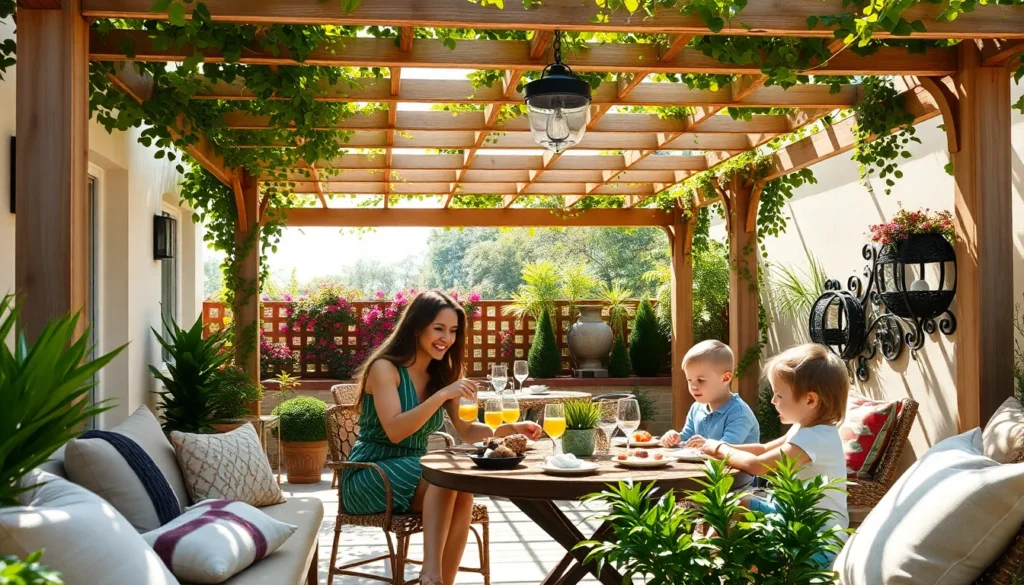Transform your outdoor space into a year-round oasis with the perfect patio cover. Whether you’re dealing with scorching summer sun or unexpected rain showers, we’ve discovered that the right overhead protection can completely revolutionize how you use your patio.
From budget-friendly DIY answers to luxurious permanent structures, today’s patio cover options offer something for every home and lifestyle. We’ll explore creative ideas that not only provide essential weather protection but also boost your property value and create an inviting outdoor room your family will love.
Ready to extend your living space beyond four walls? Let’s jump into the most popular and practical patio cover ideas that’ll help you maximize your outdoor enjoyment while staying comfortable in any weather condition.
Retractable Awnings for Flexible Sun Protection
Retractable awnings give us the perfect balance between sun protection and open sky views. We can extend them during harsh midday sun and retract them when we want to enjoy stargazing or natural light.
Manual vs. Motorized Options
Manual retractable awnings cost between $300-$1,500 and require physical effort to operate using a hand crank mechanism. We turn the crank handle clockwise to extend the awning and counterclockwise to retract it completely.
Motorized retractable awnings range from $1,000-$4,000 but offer convenience with remote control or smartphone app operation. These systems include wind sensors that automatically retract the awning during storms to prevent damage.
Battery powered models provide wireless operation without electrical connections, while hardwired versions offer unlimited power but require professional electrical installation. We recommend motorized options for awnings larger than 12 feet wide due to the physical strain of manual operation.
Fabric Choices and Durability
Acrylic fabrics like Sunbrella resist fading and water damage for 8-10 years with proper maintenance. These materials block 98% of UV rays while maintaining vibrant colors through thousands of hours of sun exposure.
Vinyl fabrics offer complete waterproofing but may crack in extreme temperatures below 20°F or above 140°F. Canvas provides natural breathability and costs 30-40% less than synthetic alternatives but requires waterproof treatments every 2-3 years.
Solution dyed fabrics maintain color integrity better than piece dyed options because pigments penetrate each fiber during manufacturing. We’ve found that striped patterns hide minor stains and wear better than solid colors over time.
Installation Considerations
Wall mounted awnings require solid attachment points capable of supporting 40-60 pounds per linear foot of awning width. We need to locate wall studs or use heavy duty masonry anchors for brick and concrete surfaces.
Freestanding awning systems work well when wall mounting isn’t possible but require concrete footings 18-24 inches deep for stability. These installations take 2-3 days longer than wall mounted versions due to concrete curing time.
Professional installation costs $200-$500 but includes proper electrical connections for motorized units and manufacturer warranty coverage. DIY installation saves money but voids warranties on most premium awning brands and may not meet local building codes.
Pergolas for Classic Outdoor Elegance
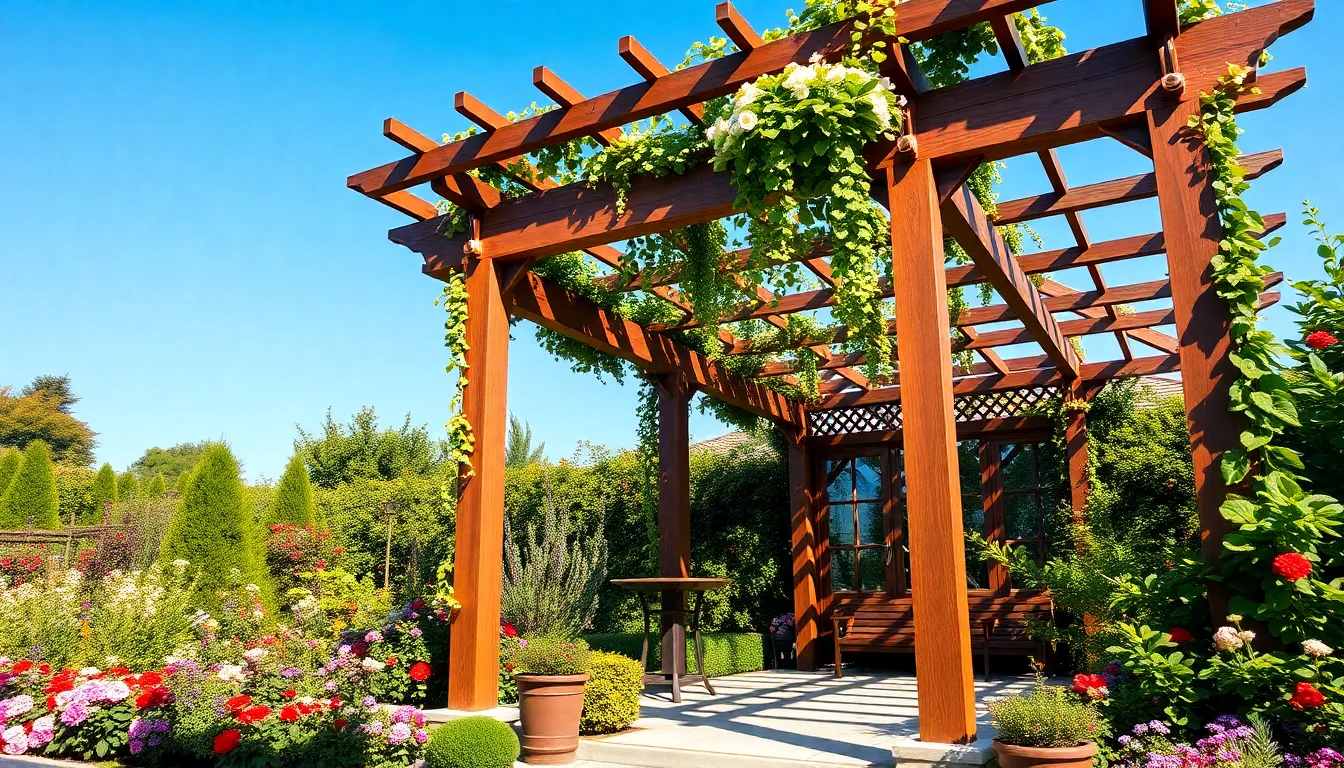
Pergolas bring timeless sophistication to outdoor spaces while providing the perfect balance of shade and open sky views. These versatile structures work beautifully as freestanding features or attached extensions that seamlessly connect your home to your garden.
Wooden Pergola Designs
Wooden pergolas offer natural beauty that complements any outdoor setting with their warm, organic appeal. Traditional cedar and redwood options provide excellent weather resistance while aging gracefully to a beautiful silver gray patina. Modern designs incorporate sleek lines and geometric patterns that work perfectly with contemporary homes and minimalist landscaping.
Rustic styles feature thick beams and rough hewn textures that create cozy gathering spaces perfect for farmhouse and cottage aesthetics. Staining options allow you to match existing deck colors or exterior trim while painted finishes can coordinate with your home’s siding for a cohesive look. Custom wooden structures can include built in benches, planters, or lighting fixtures that enhance both functionality and visual appeal.
Metal and Vinyl Alternatives
Metal pergolas deliver exceptional durability with minimal maintenance requirements that busy homeowners appreciate. Aluminum options resist rust and corrosion while remaining lightweight enough for easy installation over existing patios or decks. Steel structures provide superior strength for larger spans and can support heavier climbing plants or hanging decorations.
Vinyl pergolas mimic the appearance of painted wood without the ongoing maintenance of scraping, sanding, or repainting. These synthetic materials resist fading, cracking, and insect damage while maintaining their appearance for decades with simple soap and water cleaning. Powder coated finishes on metal frames come in various colors from classic white and black to earth tones that blend naturally with outdoor environments.
Adding Climbing Plants for Natural Shade
Climbing plants transform pergolas into living structures that provide increasing shade and privacy as they mature. Wisteria creates stunning purple or white flower displays in spring while developing thick canopies that offer substantial summer shade. Clematis varieties bloom in multiple colors throughout the growing season and require less aggressive pruning than other vigorous climbers.
Grapevines serve dual purposes by producing edible fruit while creating dense overhead coverage that filters sunlight beautifully. Boston ivy and Virginia creeper provide rapid coverage and spectacular fall color changes that enhance seasonal interest. Training systems using wire or wooden lattice panels help guide plant growth and create uniform coverage across pergola surfaces for optimal shade distribution.
Gazebos for Complete Weather Coverage
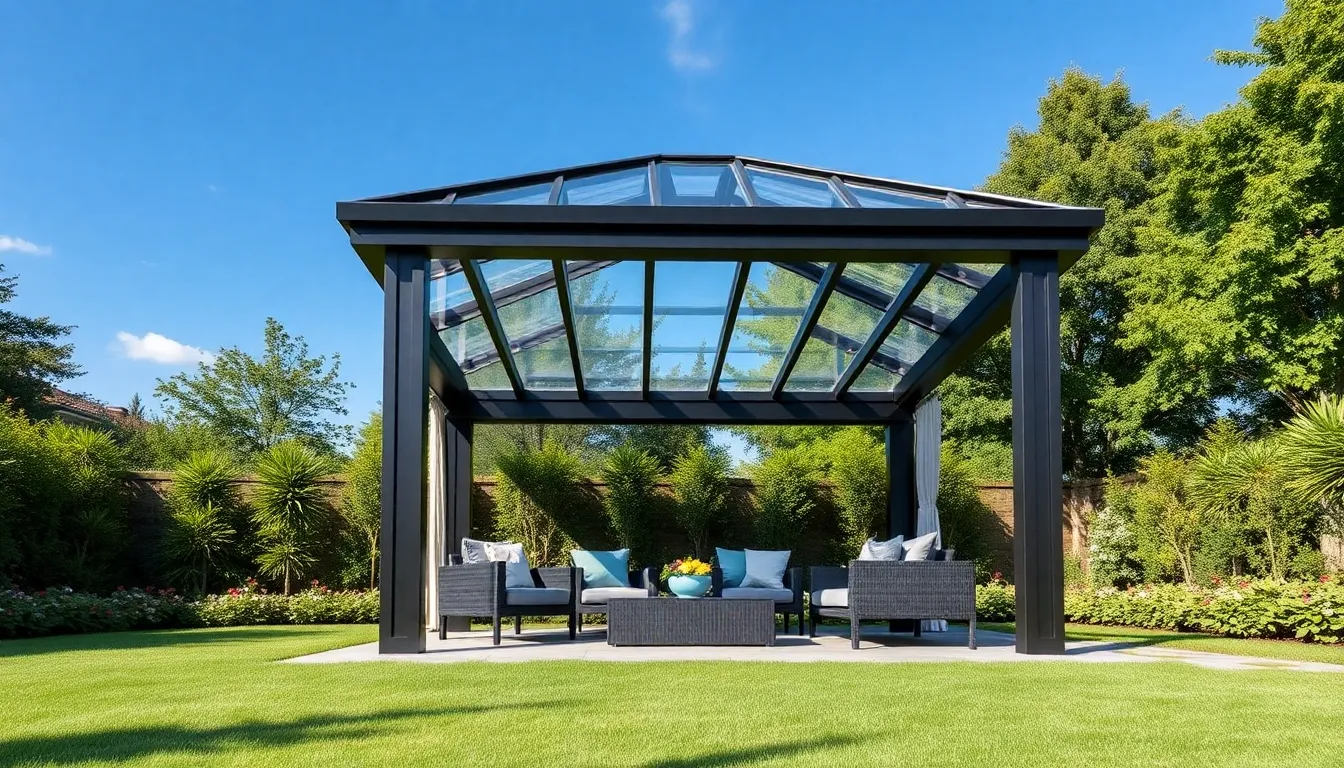
Gazebos provide the ultimate outdoor shelter solution, offering complete protection from rain, wind, and harsh sunlight. These freestanding structures create a defined outdoor room that transforms any backyard into a year round entertaining space.
Traditional Octagonal Gazebos
Traditional octagonal gazebos feature the classic eight sided design that’s become synonymous with outdoor elegance. Wood construction dominates this style, with cedar and pressure treated lumber offering natural beauty that weathers gracefully over time. These structures typically measure 8 to 16 feet in diameter, providing ample space for outdoor dining sets or lounge furniture.
Popular placement options include garden centers, backyard corners, or poolside locations where the gazebo becomes a focal point. Metal alternatives using aluminum or steel frames offer increased durability while maintaining the traditional aesthetic. The octagonal shape maximizes interior space while providing structural stability against wind loads.
Most traditional designs include decorative elements like lattice work, carved brackets, or cupola tops that enhance visual appeal. Installation typically requires a concrete foundation or treated lumber platform to ensure longevity and stability.
Modern Rectangular Designs
Modern rectangular gazebos offer sleek contemporary lines that complement today’s architectural styles. These structures maximize usable space with their efficient four sided design, making them ideal for smaller yards or exact functional needs. Materials range from powder coated aluminum frames with polycarbonate roofing to engineered wood composite systems.
Dimensions commonly span 10×12 feet to 12×16 feet, accommodating larger outdoor furniture arrangements or multiple activity zones. Clean lines and minimal ornamentation define the modern aesthetic, with flat or low pitched roofs creating a streamlined appearance.
Integration with existing home architecture becomes seamless when matching materials and color schemes to the main structure. Many modern designs incorporate removable panels or adjustable louvers for customizable weather protection and ventilation control.
Screened In Options for Bug Protection
Screened in gazebos combine complete weather coverage with effective insect protection, creating comfortable outdoor spaces in bug prone areas. Fine mesh screening allows natural airflow while blocking mosquitoes, flies, and other unwanted pests from disturbing outdoor activities.
Frame materials include aluminum, steel, or treated wood that support both roof loads and screen tension. Screen options range from standard fiberglass mesh to premium materials like pet resistant or solar screening that reduces glare and heat.
Door systems typically feature spring loaded hinges or magnetic closures that prevent gaps where insects might enter. Some designs incorporate removable screen panels for seasonal flexibility, allowing conversion between screened and open configurations.
Flooring considerations include elevated decking, concrete pads, or gravel bases that promote drainage while preventing ground moisture issues. These structures excel for outdoor dining areas where food preparation and consumption require insect free environments.
Shade Sails for Contemporary Style
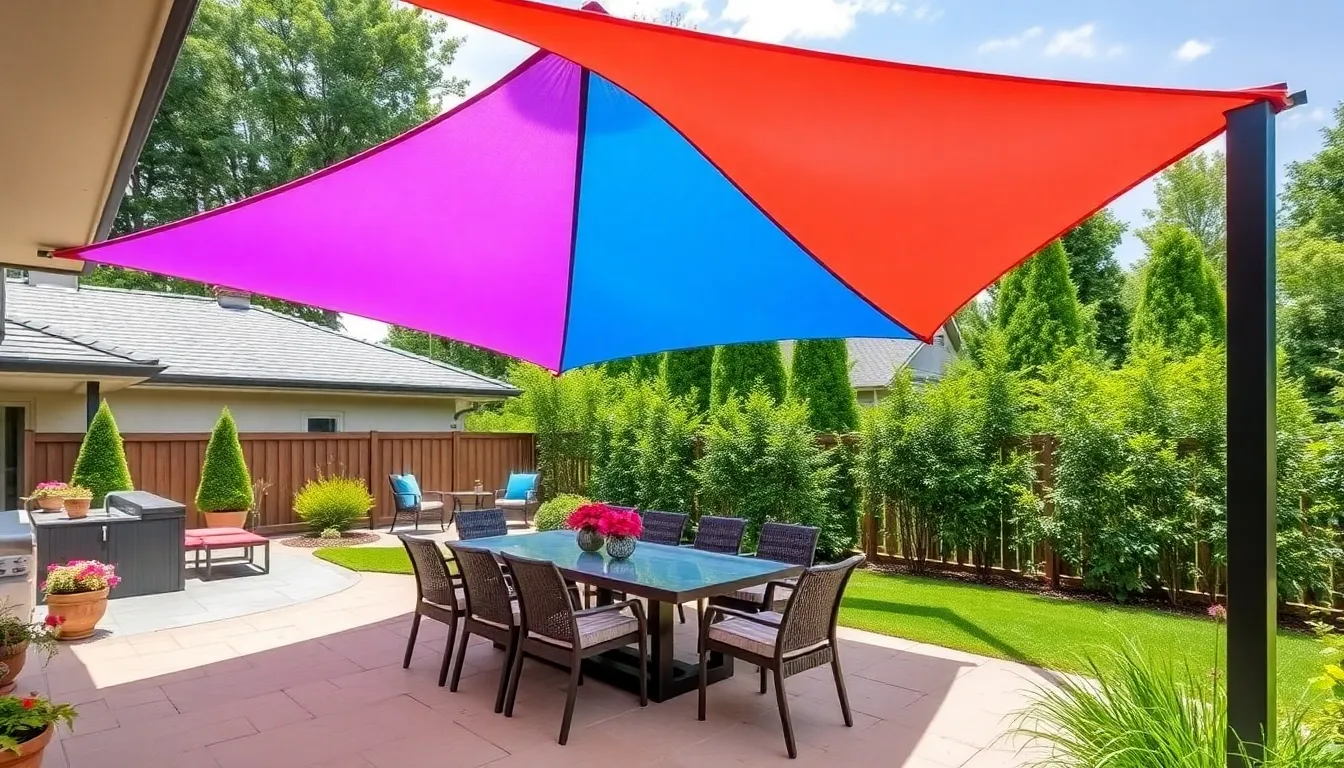
We’ve discovered that shade sails offer one of the most striking modern approaches to patio coverage, delivering sleek aesthetics alongside practical functionality. These versatile covers bring contemporary flair to outdoor spaces while providing essential weather protection.
Triangle and Square Configurations
Triangular shade sails excel in compact spaces and can be combined with other shapes for elaborate setups. Multiple triangles create stunning visual impact when covering larger areas or forming complex geometric designs. The slanted triangle design particularly appeals to homeowners seeking both style and function, as its angled slope naturally directs moisture runoff away from gathering areas.
Square configurations work exceptionally well for square outdoor table sets and dining areas. Popular brands including Portofino, Meridian, Regent, and Seasons manufacture square covers featuring diverse materials and innovative designs. Corner pergolas and gazebos also benefit from triangular configurations, creating intimate spaces that maximize limited square footage.
Material Selection and UV Protection
Marine grade canvas and solution dyed polyester represent the gold standard for shade sail construction. These premium materials receive specialized UV treatments that ensure longevity against intense sun exposure. Portofino covers use 300D marine grade fabric enhanced with UV and antimicrobial treatments for superior durability.
Regent covers feature 100% solution dyed Sunbrella fabric engineered with high UV blockage capabilities. This advanced fabric technology prevents color fading while maintaining structural integrity season after season. Weather resistant treatments protect against moisture, mold, and mildew formation.
Mounting and Tensioning Systems
Secure mounting requires anchoring shade sail corners to sturdy structures like posts, walls, or dedicated support frames. Professional installation ensures proper load distribution and structural safety for long term performance. Tensioning systems maintain the sail’s optimal shape while preventing dangerous sagging that could compromise wind resistance.
Proper tension prevents pooling during rainfall and maintains the sail’s aerodynamic properties in windy conditions. We recommend adjustable hardware that allows seasonal tension modifications as fabric naturally stretches over time. Quality mounting systems distribute stress evenly across all attachment points.
Patio Umbrellas for Portable Convenience

When we need instant shade that moves with our needs, patio umbrellas offer the perfect blend of flexibility and functionality. These versatile shade answers let us create comfortable outdoor spaces wherever we want them.
Market Umbrellas and Cantilever Styles
Market umbrellas serve as the classic choice for residential patios, featuring a centered pole design that provides straightforward shade coverage. We often see these traditional umbrellas anchored directly through patio tables or positioned with standalone bases. Their simple operation and reliable performance make them ideal for smaller outdoor spaces and budget-conscious homeowners.
Cantilever umbrellas revolutionize patio shading with their off-center design that maximizes usable space beneath the canopy. These innovative umbrellas mount to one side, eliminating the central pole obstruction that can interfere with furniture placement or foot traffic. We recommend cantilever styles for larger patios, poolside areas, and dining spaces where unobstructed movement is essential.
Base Options and Stability Features
Free-standing bases come in various materials including concrete, stone, and resin, offering versatility that suits different patio styles and aesthetic preferences. These bases provide the foundation for safe umbrella operation while complementing our outdoor décor choices.
Cantilever umbrella bases require significantly more weight due to their off-center design, which creates additional leverage that standard bases can’t handle safely. Heavy-duty bases made from granite or stone materials provide the necessary stability to prevent dangerous tipping incidents.
Weather-resistant coatings on metal bases extend durability by protecting against rust and corrosion from rain and wind exposure. These protective finishes ensure our umbrella bases maintain their structural integrity and appearance season after season.
Fabric Care and Storage Tips
Regular cleaning with mild soap and water prevents stains from setting into umbrella fabric while extending the overall lifespan of our investment. We should address spills and dirt promptly to maintain the fabric’s appearance and protective qualities.
Proper storage during harsh weather conditions protects umbrella fabric from unnecessary wear and potential damage. Storing umbrellas in dry, covered areas when not in use significantly extends their functional life and preserves their visual appeal.
Seasonal maintenance includes inspecting fabric for tears, checking hardware for rust, and ensuring all moving parts operate smoothly before each use period.
Roof Extensions for Permanent Solutions
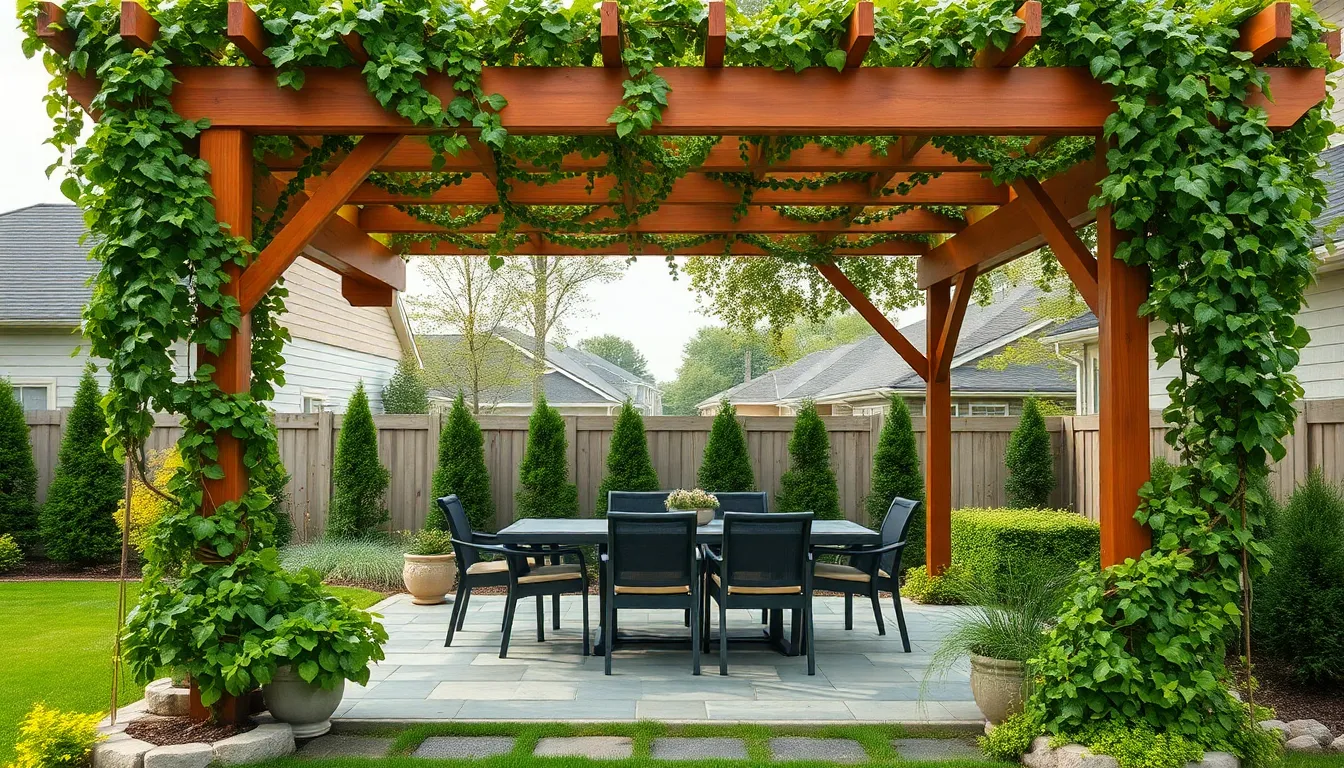
When you’re ready to move beyond temporary shade answers, permanent roof extensions offer the ultimate in outdoor protection and property value enhancement. These structures become integral parts of your home, providing year-round coverage that withstands all weather conditions.
Attached Patio Roof Designs
Wood pergolas create stunning outdoor spaces when you incorporate climbing plants like ivy for natural coverage. These structures offer aesthetic appeal while integrating seamlessly into your existing home architecture, making them perfect for homeowners who want both beauty and functionality.
Log cabin style roofs bring rustic charm to your outdoor area using thick wooden logs that complement countryside or natural home themes. We’ve seen these designs particularly shine when paired with stone patios or natural landscaping elements.
Aluminum louvered roofs feature adjustable louvers that give you complete control over shade and shelter throughout the day. These modern designs provide exceptional functionality while maintaining a sleek appearance that works well with contemporary home styles.
Polycarbonate panels deliver natural light filtration while protecting against harsh weather elements like hail and heavy rain. We recommend these panels for homeowners who want covered outdoor dining areas that still feel bright and airy.
Gutter Integration and Water Management
Proper gutter systems prevent water accumulation around your patio structure, protecting both your investment and your home’s foundation. We always emphasize the importance of professional gutter installation to ensure proper water flow away from your outdoor living space.
Slope considerations become critical when designing your roof extension to direct water toward gutters effectively. Professional contractors typically recommend a minimum slope of 1/4 inch per foot to ensure adequate drainage without compromising the structure’s appearance.
Downspout placement requires strategic planning to channel water away from high traffic areas and landscaping. We suggest incorporating decorative downspouts that complement your patio cover design while maintaining functionality.
Matching Your Home’s Architecture
Material selection should complement or match your home’s existing architectural style for visual harmony. Metal frames suit modern homes perfectly, while wood materials enhance traditional or rustic designs, creating a cohesive outdoor living environment.
Design consistency ensures your patio cover enhances rather than detracts from your home’s curb appeal. We recommend working with designers who understand how to blend new structures with existing architecture seamlessly.
Color coordination plays a vital role in creating a unified look between your home and patio cover. Neutral tones like whites, grays, and earth tones typically work well across various architectural styles, while bold colors should match existing accent features on your home.
Outdoor Curtains for Versatile Privacy
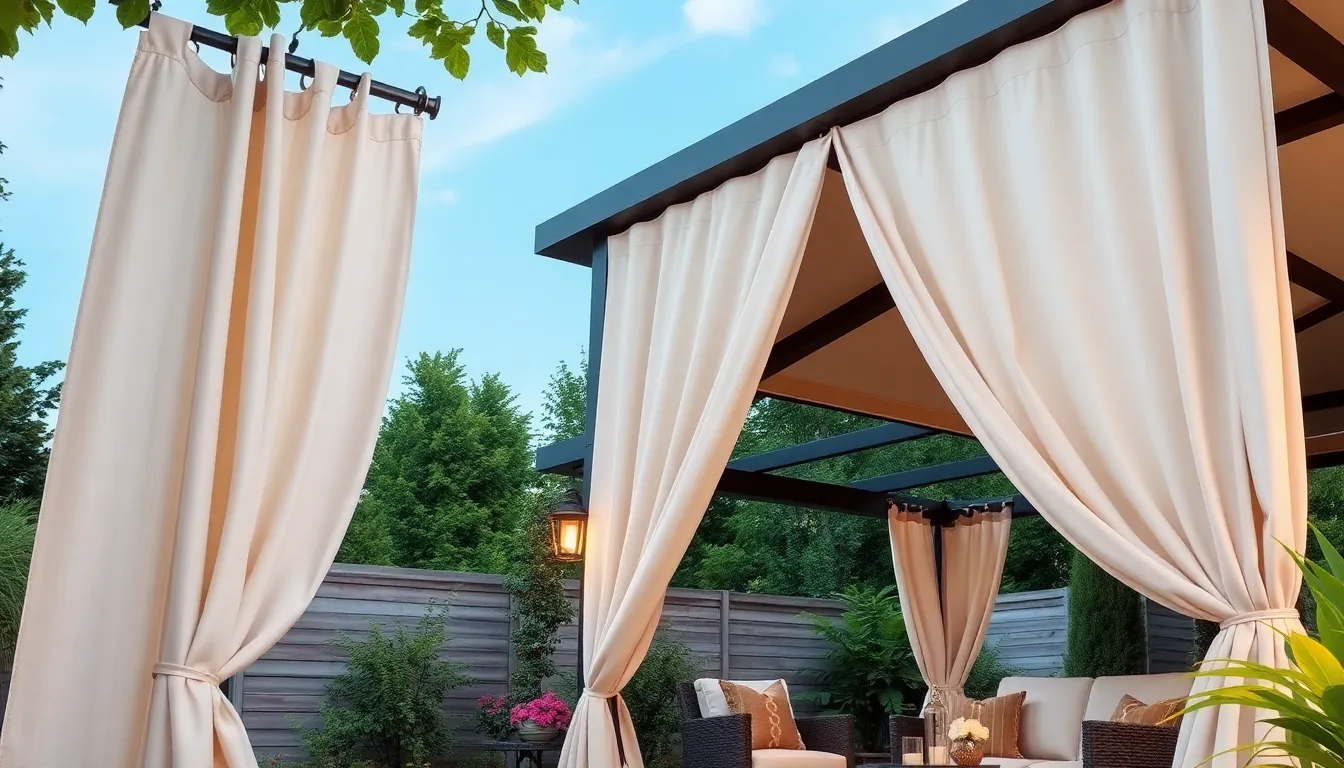
Building on our permanent cover answers, outdoor curtains offer a flexible way to enhance privacy while controlling sunlight and airflow around your patio space. These versatile additions complement any patio cover design we’ve discussed, from pergolas to gazebos.
Weather-Resistant Fabric Options
Sunbrella fabric stands out as the premier choice for outdoor curtains, delivering exceptional water resistance and UV protection that keeps your investment looking fresh season after season. This trusted material maintains its color and structural integrity even under harsh weather conditions.
Polyester blends provide excellent durability at a more budget-friendly price point, offering resistance to fading and moisture while maintaining their shape over time. Canvas materials bring a classic aesthetic to your outdoor space while delivering the weather resistance needed for year-round use.
Marine-grade fabrics excel in coastal environments where salt air and high humidity challenge standard materials. These specialized textiles resist mildew and corrosion, making them ideal for homes near water.
| Fabric Type | UV Protection | Water Resistance | Durability Rating |
|---|---|---|---|
| Sunbrella | Excellent | High | 8-10 years |
| Polyester | Good | Moderate | 5-7 years |
| Canvas | Good | Good | 6-8 years |
| Marine-grade | Excellent | Excellent | 10+ years |
Hanging Systems and Hardware
Sturdy rod systems form the foundation of reliable curtain installation, requiring heavy-duty materials that withstand wind and weather without sagging or breaking. We recommend stainless steel or powder-coated aluminum rods for maximum longevity.
Track systems offer smooth operation and professional appearance, allowing curtains to glide effortlessly along the length of your patio cover. These systems work particularly well with heavier fabrics and provide consistent spacing.
Automated mechanisms bring convenience to your outdoor space, letting you control curtains with the touch of a button or smartphone app. Motorized systems integrate seamlessly with smart home technology and eliminate the need for manual adjustment during weather changes.
Grommets and tie-backs provide additional hanging options that complement various architectural styles while ensuring secure attachment points. Reinforced grommets prevent tearing in windy conditions, while decorative tie-backs add functional elegance.
Color Coordination with Patio Decor
Neutral tones like beige, gray, and cream create versatile foundations that complement most patio furniture and architectural elements we’ve covered in previous sections. These colors blend seamlessly with natural materials like wood and stone.
Earth tones enhance the organic feel of pergolas with climbing plants, creating harmony between your curtains and natural elements. Warm browns and sage greens work particularly well with wooden structures and outdoor greenery.
Bold accent colors can transform your covered patio into a vibrant outdoor room, especially when coordinated with cushions, umbrellas, or decorative elements. Deep blues and rich reds create striking focal points without overwhelming the space.
Striped patterns add visual interest while maintaining sophistication, particularly effective when the stripe colors echo other design elements in your outdoor living area. Vertical stripes can make your patio appear taller, while horizontal patterns create width.
Living Canopies Using Trees and Vines
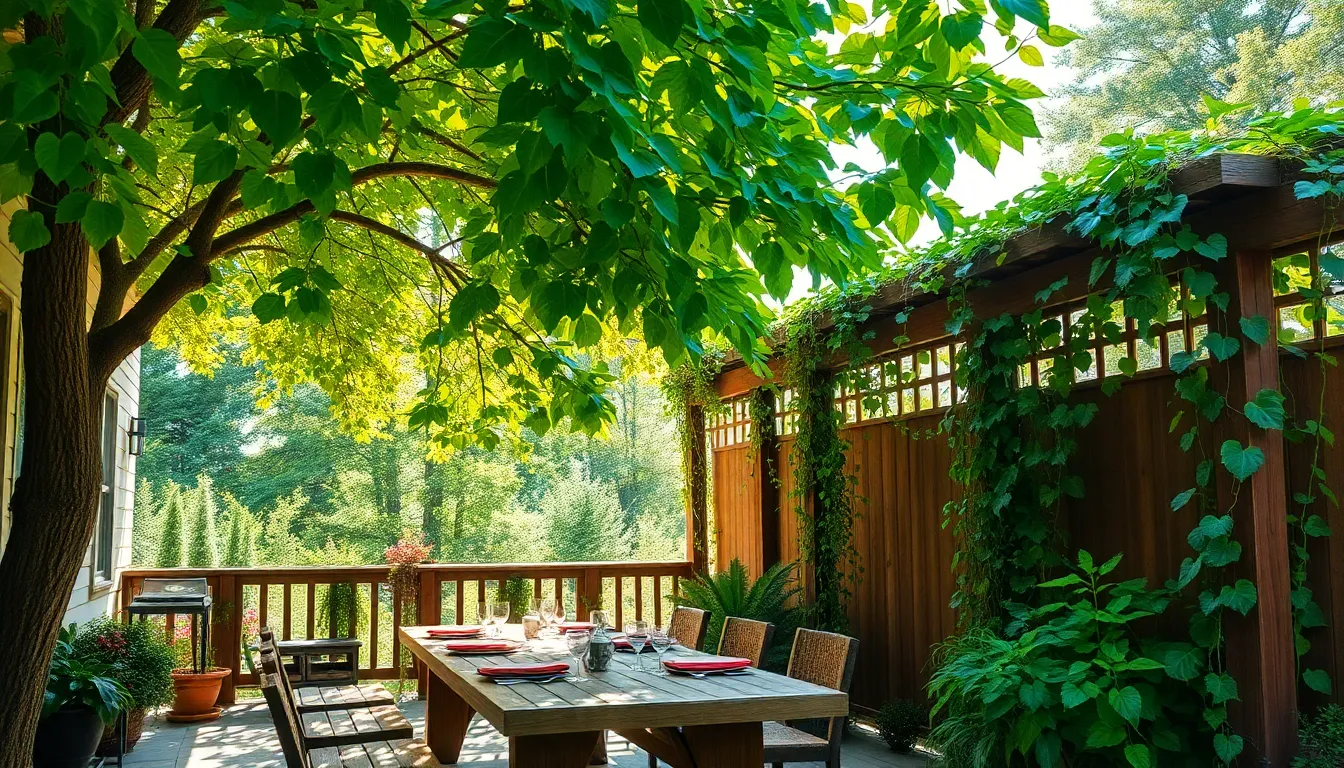
Nature provides some of the most elegant patio cover answers through strategically planted trees and climbing vines. These living canopies offer sustainable shade while creating beautiful, ever-changing outdoor environments.
Fast-Growing Shade Trees
Willow trees stand out as exceptional choices for rapid patio coverage, delivering impressive growth rates that transform outdoor spaces within just a few seasons. These adaptable trees create dense foliage canopies perfect for blocking harsh sunlight while maintaining natural beauty throughout the growing season.
Poplar trees excel at forming extensive overhead coverage, making them ideal candidates for larger patio areas requiring substantial shade. Their rapid vertical growth and spreading branches create natural umbrellas that can cover important ground space effectively.
Maple varieties like silver maples provide quick establishment with broad leaf coverage that filters sunlight beautifully. These trees adapt well to various soil conditions and offer the bonus of spectacular fall color displays.
Hybrid oak species combine traditional oak elegance with accelerated growth patterns, delivering sturdy branches and thick foliage perfect for long-term patio shade answers.
Vine-Covered Trellis Systems
Pergola vine training transforms basic overhead structures into lush green canopies using climbing plants like wisteria or grapevines. These systems allow filtered sunlight to create dappled shade patterns while providing substantial coverage during peak growing seasons.
Trellis installation requires sturdy framework capable of supporting mature vine weight, with posts anchored at least 2 feet deep for stability. Wire or wooden slat systems guide vine growth direction while creating attractive geometric patterns overhead.
Clematis varieties offer spectacular flowering displays combined with dense foliage coverage, making them perfect for creating romantic patio environments. These versatile climbers adapt to various light conditions and provide seasonal interest through different bloom periods.
English ivy systems deliver year-round coverage with evergreen foliage that maintains patio privacy and shade through all seasons. This hardy vine requires minimal maintenance once established and creates thick, luxurious green walls.
Grape vine installations serve dual purposes by providing overhead shade plus edible fruit harvests, making them practical choices for food-conscious homeowners. These vigorous growers require annual pruning but reward gardeners with both beauty and bounty.
Natural Cooling Benefits
Temperature reduction occurs naturally as tree and vine canopies block direct sunlight, with studies showing covered areas staying 10-15 degrees cooler than exposed spaces. Dense foliage acts as natural air conditioning by preventing heat buildup on patio surfaces.
Enhanced air circulation develops as plant canopies create microclimates that encourage gentle breezes and air movement. Leaves release moisture through transpiration, adding humidity that creates comfortable outdoor environments even during hot weather.
Energy cost savings result from reduced need for artificial cooling systems in adjacent indoor spaces, as living canopies prevent heat transfer through windows and walls. Properly positioned shade trees can reduce home cooling costs by up to 30% during summer months.
Oxygen production improves air quality around patio spaces as trees and vines convert carbon dioxide into fresh oxygen throughout daylight hours. This natural air purification creates healthier outdoor environments for family gatherings and relaxation.
DIY Patio Cover Projects for Budget-Conscious Homeowners
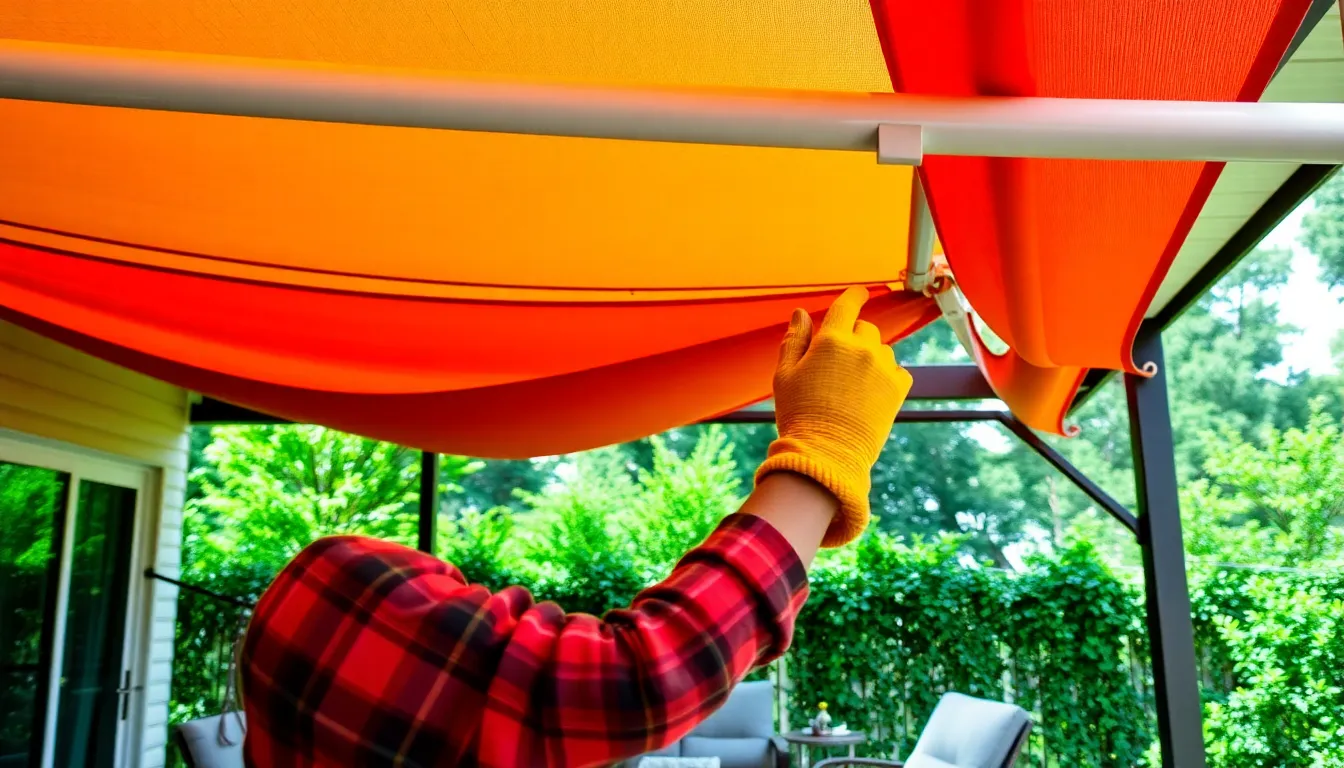
Creating affordable patio covers doesn’t require very costly or hiring contractors. We’ll explore practical DIY answers that deliver impressive results while keeping costs under control.
Simple Canvas and Frame Constructions
Fabric canopies transform ordinary household items into effective shade answers by repurposing tablecloths, shower curtains, or patterned sheets. We can hang these colorful materials from simple wooden frames or stretch them between existing structures like fence posts or house eaves. Canvas drop cloths from hardware stores work exceptionally well for this purpose and cost significantly less than purpose-made awning fabric.
Shade sails create stunning visual impact when combined with strategically placed posts and decorative string lights. These triangular or square fabric panels attach to anchor points using tensioning hardware, allowing us to customize coverage areas based on our patio’s unique layout. We recommend starting with smaller 10×10 foot sails before expanding to larger configurations.
PVC pipe frames offer lightweight support for fabric coverings and require minimal construction skills to assemble. These frames can be designed as freestanding structures or attached to existing walls, providing flexibility for renters who can’t make permanent modifications. Coupling joints allow us to create custom shapes and sizes to fit any patio dimension.
Repurposed Materials and Creative Answers
Upcycled wood pallets create rustic seating arrangements that double as structural support for overhead coverings. We can stack pallets vertically to form walls, then top them with reed mats or bamboo screening for an authentic outdoor room feel. Sanding and staining these pallets transforms industrial materials into attractive furniture pieces.
Carport covers adapt easily to patio applications by repositioning the metal framework over outdoor living spaces. These pre-engineered structures often cost less than custom-built alternatives and provide reliable weather protection. We can enhance their appearance by adding decorative elements like lattice panels or climbing plant supports.
Lean-to patio covers use existing house walls as primary support, reducing material costs to under $200 for most installations. These sloped roof designs shed water effectively while creating intimate covered spaces perfect for dining or relaxation. Basic lumber and corrugated roofing panels complete most lean-to projects.
Repurposed doors and windows create unique architectural features when incorporated into patio cover designs. Old shutters make excellent privacy screens, while salvaged windows can be mounted horizontally to create partial roof sections that allow filtered light. These materials often come free from renovation projects or demolition sites.
Tools and Skills Required
Basic carpentry tools include hammers, handsaws, cordless drills, and measuring devices necessary for most DIY patio projects. We recommend investing in a quality circular saw for cutting lumber efficiently and a level for ensuring proper installation. Socket wrench sets help with hardware assembly, particularly for shade sail installations.
DIY skills cover light carpentry abilities like measuring, cutting, and basic joinery techniques using screws and bolts. Most projects require understanding of structural principles to ensure safe load bearing, especially for overhead installations. We suggest practicing on smaller projects before attempting complex roof structures.
Safety equipment protects against common construction hazards through proper use of safety goggles, work gloves, and hearing protection. Fall protection becomes essential when working above ground level, so we always recommend using stable ladders with spotters. First aid supplies should remain accessible during all construction activities.
Planning considerations include checking local building codes before beginning construction, as some jurisdictions require permits for permanent patio covers. We must also consider our home’s architectural style to ensure new additions complement existing design elements. Proper site preparation prevents future structural problems and ensures professional-looking results.
Conclusion
We’ve explored an impressive range of patio cover answers that can transform your outdoor space into a year-round retreat. From budget-friendly DIY projects using repurposed materials to elegant permanent structures that boost property value each option offers unique benefits for different lifestyles and budgets.
The key is choosing a solution that matches your exact needs climate and aesthetic preferences. Whether you opt for the flexibility of retractable awnings the natural beauty of living canopies or the complete protection of gazebos you’re investing in more comfortable outdoor living.
Your perfect patio cover is waiting to enhance those precious moments spent outdoors with family and friends.
Frequently Asked Questions
What are the most popular types of patio covers?
The most popular patio covers include retractable awnings, pergolas, gazebos, shade sails, and patio umbrellas. Each offers different benefits: awnings provide flexible sun protection, pergolas blend shade with open sky views, gazebos offer complete weather coverage, shade sails create modern aesthetics with functionality, and umbrellas provide portable convenience for smaller spaces.
How much do retractable awnings typically cost?
Retractable awnings vary significantly in price depending on size and features. Manual awnings are more budget-friendly, while motorized options with remote control capabilities cost more. The investment includes the awning unit, professional installation (especially recommended for motorized models), and durable UV-resistant fabrics. Costs also depend on whether you choose wall-mounted or freestanding systems.
What’s the difference between pergolas and gazebos?
Pergolas are open-roof structures that provide partial shade while maintaining sky views, perfect for balancing sun protection with openness. Gazebos are fully enclosed structures with complete roofs, offering total weather protection from rain, wind, and harsh sunlight. Pergolas enhance elegance and can support climbing plants, while gazebos create defined outdoor rooms.
Are shade sails difficult to install?
Shade sails require careful planning for secure mounting and proper tensioning systems. While the concept seems simple, professional installation is recommended for long-term reliability and safety. Key considerations include selecting appropriate anchor points, ensuring correct sail tension, choosing durable marine-grade materials, and understanding wind load requirements for your specific configuration.
What materials work best for outdoor curtains?
Weather-resistant fabrics are essential for outdoor curtains. Top choices include Sunbrella fabrics for superior durability, polyester blends for affordability, canvas for classic appeal, and marine-grade fabrics for maximum weather protection. These materials resist fading, moisture, and mildew while providing privacy and light control around patio spaces.
Can I build a patio cover myself?
Yes, many patio covers can be DIY projects. Simple options include canvas and frame constructions using repurposed materials, PVC pipe frames, upcycled wood pallets, and carport-style lean-to designs. Basic tools and safety equipment are required. However, complex installations like motorized awnings or permanent roof extensions typically require professional installation.
How do living canopies compare to traditional patio covers?
Living canopies created by trees and climbing vines offer sustainable, natural shade that improves over time. They provide temperature reduction, enhanced air circulation, energy savings, and improved air quality. Fast-growing options like willows and poplars create quick coverage. However, they require ongoing maintenance and take time to establish compared to immediate coverage from traditional covers.
What factors should I consider when choosing patio cover colors?
Color coordination significantly impacts your outdoor space’s appeal. Neutral tones offer timeless versatility, earth tones blend naturally with landscapes, bold accent colors create focal points, and striped patterns add visual interest. Consider your existing patio decor, home exterior colors, and desired atmosphere when selecting covers to create a cohesive, inviting environment.

